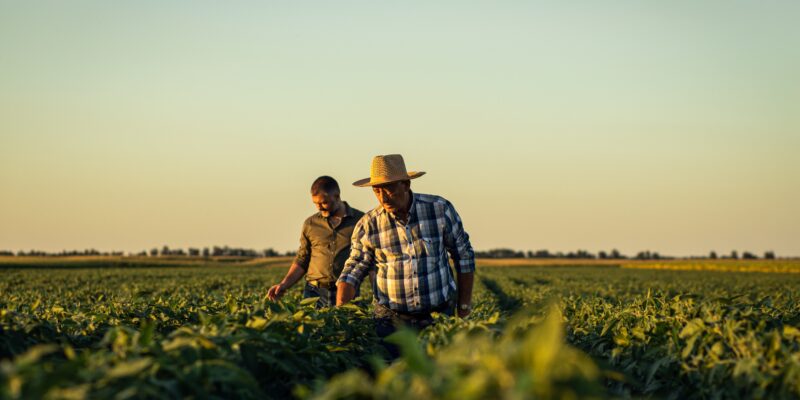Article 6 of the Paris Agreement at COP28: What is at stake?
Developing stringent rules for the global carbon market under A6.4 could set a precedent for high standards and restore faith…

Smallholder farming is the most common type of agriculture in the world.[1]Smallholder farmers are small-scale farmers, pastoralists, forest keepers and fishers who manage smaller tracts of land, using mainly family labour and dedicating at least some of the produce to … Continue reading Farms of less than two hectares in size produce around one-third of the world’s food, while those two to five hectares in size produce almost half. Farms of less than five hectares located in developing countries account for more than half of the global production of nine staple crops – rice, peanut, cassava, millet, wheat, potato, maize, barley and rye – demonstrating their importance for global food security. As shown in Figure 1, farms of less than two hectares produce the majority of rice (>80%), peanut (75%), cassava and millet (~60%) globally. Smallholder farmers are also major producers of food that is consumed in their country. For example, smallholders in Tanzania meet around 69% of national food demand, and 2.7 million smallholder farmers in Nepal produce around 70% of their country’s food.

The role different size smallholdings play in producing food calories varies by region (Figure 2). In Asia, farms of less than five hectares produce 90% of food calories, whereas in Sub-Saharan Africa, farms of this size produce around half of food calories and farms of 5-15 hectares produce another 26%. By contrast, 70% of food calories in Latin America are produced on larger farms (> 15 hectares), while only 7% are produced on farms of less than five hectares.[3]This estimate is based on 41 major food crops.

Farms of smaller than two hectares produce around one-third of the world’s food on just one-quarter of the world’s agricultural land and those two to five hectares in size produce 46% of food on one-third of agricultural land. Small-scale farms have been found to have higher land productivity – the farm’s output per unit of land area – than larger farms. For example, in Kenya, a farmer farming on less than half a hectare of land produces USD 888 of food per hectare on average, whereas a farmer farming on two hectares of land produces food to the value of USD 330 per hectare.
On average, smallholder farms dedicate a larger share of their land to food crops – rather than animal feed or fuel – compared to larger farms. Around 70% of the calories produced on smallholder farms of less than five hectares are available as food, compared to 55% for the global agricultural system.2
Another reason smallholder farms are able to achieve high productivity is their high labour intensity. Employing family members allows for a higher number of labourers per hectare and keeps labour transaction costs low.
As smallholder farmers need to optimise production on small tracts of land, they also tend to use more inputs, such as fertiliser and seeds, than larger farms.[5]This comparison is between small and large farms within the same country. For example, smallholder rice farmers in Bangladesh apply 181 kg of fertiliser on average per hectare, whereas larger farms only apply around 130 kg.
Though smaller farms are more productive than their larger counterparts in many developing countries, yields could be improved with the adoption of modern technologies and optimised inputs, such as fertiliser, manure and seeds. This ‘yield gap’ – the amount by which yields could be improved – ranges from 11% in East Asia to up to 76% in Sub-Saharan Africa, emphasising the significant potential for farmers in developing countries to contribute even further to rural and national food security.
Reaching this potential is contingent on smallholder farmers having access to and participating in modern food supply chains. For example, smallholder farmers may not have access to roads or transport to get their produce to market, they may lack access to suitable storage facilities to reduce food spoilage, or they may not have access to the technology needed to communicate with buyers or to learn about food safety and quality control requirements.
Ensuring that smallholder farmers can access modern agrifood supply chains is critical for ensuring food security, productivity and nutrition. Smallholder farmers produce some of the world’s most important agricultural products. For example:
Smallholder farms have a potential competitive advantage over larger farms when producing labour-intensive and high-value products, though they face difficulties linking these products to modern value chains. Growth and investment in smallholder agriculture has significant potential to alleviate poverty for smallholder farmers while concurrently supporting global food security.
For example, obtaining an Ecocert Organic Standard certification allowed pineapple growers in Zimbabwe to sell their organic produce internationally. Accessing these supply chains will enhance the farmers’ livelihoods – their pineapples could fetch as much as a 30% premium in European supermarkets. Obtaining this certification was made possible with assistance from organisations including the Committee linking Entrepreneurship – Agriculture – Development (COLEAD), the Embassy of Netherlands in Zimbabwe, the Netherlands-based Programma Uitzending Managers (PUM) and the Netherlands Enterprise Agency (RVO), highlighting the importance of collaboration in facilitating access of smallholder farmers to international food supply chains.
Similarly, smallholder avocado farmers in Tanzania were able to access the European export market through help from the private sector companies Africado and Rungwe Avocado Company, both supported by US food security initiative Feed the Future. Another example is macadamia nuts in Malawi, where a Dutch-Malawian partnership has facilitated the export of sustainably-produced macadamias to the European market.
Agriculture contributes substantially to the GDP of many developing nations, with smallholder farming playing a significant role. For instance, in Sub-Saharan Africa, where the majority (up to 80%) of farming is done by smallholder farmers, agriculture contributes 23% to GDP. Agriculture GDP values are even higher for certain African countries – for example, 41% of the GDP of Liberia and 31% of the GDP of Guinea-Bissau is attributed to agriculture.
In Sub-Saharan Africa, more than 60% of the population are smallholder farmers and smallholder farms employ up to 65% of the labour force. Around 73% of the population of Tanzania lives in rural areas, where 3.7 million smallholdings support up to 19 million people. In Malawi, smallholder farmers produce 80% of the country’s food and more than 80% of the working population are employed in agriculture.
Sustainable and climate-smart agricultural practices are already an integral part of many indigenous farming systems. For example, traditional fallow systems, crop rotation and water harvesting practices in the Sahel aim to improve crop yields and livelihoods, and conserve water. In Nigeria, indigenous knowledge and practices are implemented by farmers to improve agricultural productivity and food availability, including mulching, using organic manure, using locally made pesticide, no-tillage and treating seeds with ash for long-term preservation. In South Africa, subsistence farmers use indigenous knowledge and practices such as planting in different soil types, fertilising soil with manure, selecting seeds by colour and size, and storing seeds in ash in clay pots and baskets to preserve them.

Figure 3 shows 17 different climate-smart farming practices that are used by farmers in Sub-Saharan Africa.[6]Fourteen Sub-Saharan African countries were included in the analysis: South Africa, Zimbabwe, Malawi, Zambia, Tanzania, Kenya, Uganda, Ethiopia, Cameroon, Nigeria, Niger, Burkina Faso, Ghana and … Continue reading The most widely-adopted practice is using organic manure, followed by agroforestry (where annual crops or pastures are farmed together with trees or shrubs), crop rotation and crop diversification. In Ghana, smallholder farmers use a range of climate-smart agricultural practices, including timely harvesting and storing of produce, crop rotation, appropriate and timely weed and pest control, appropriate fertiliser use, mixed cropping (where two or more crops are grown simultaneously), planting legumes among crops, conservation agriculture (agriculture focused on regenerating degraded lands and preserving arable land) and agroforestry, among others. The primary motivations for adopting these practices are improving household food security, reducing pests and diseases, increasing yields and farm income, and controlling erosion and protecting soil. In Nicaragua, smallholder coffee producers implement agroforestry to reduce production costs, improve livelihoods and diversify income.

Smallholder farmers tend to plant a greater diversity of crops than larger farms in order to improve nutrition, mitigate drought risk and for market diversification (Table 1). Smallholder farms also have higher non-crop biodiversity than larger farms, which has been attributed to the use of ecological management practices, such as limited insecticide use, the presence of field edges – which provide a habitat and breeding ground for insects – and diverse land-cover types, such as forests, fields and wetlands. Smallholder farms within and around cities can also improve the environment by reducing urban heat island effects and can improve access to easy and affordable nutritious foods for city dwellers.
The availability of finance has been identified as one of the most significant factors influencing whether smallholder farmers in Africa adopt climate-smart agricultural practices. In Malawi, access to credit was found to be a major factor dictating the adoption of climate-smart agriculture. In Ghana, maize farmers farming smaller lands face more credit constraints than those farming larger lands. Both private and public financing approaches are needed to encourage the adoption of sustainable agricultural practices by smallholder farmers, who are often lacking the necessary financial resources.
In Kenya, farmers that are more likely to adopt climate-resilient farming practices are those that sell their produce to markets (as opposed to farming entirely for subsistence) and have off-farm activities related to agricultural supply chains, such as milling their grains to add value to their produce or hiring out their farm equipment. Having individual land tenure rights and having middle to high school education were also found to be factors.
References
| ↑1 | Smallholder farmers are small-scale farmers, pastoralists, forest keepers and fishers who manage smaller tracts of land, using mainly family labour and dedicating at least some of the produce to household consumption. |
|---|---|
| ↑2, ↑4 | This study used data on smallholder farms from 83 countries in Latin America, Sub-Saharan Africa, and South and East Asia, which is where 90% of the world’s farms are located. |
| ↑3 | This estimate is based on 41 major food crops. |
| ↑5 | This comparison is between small and large farms within the same country. |
| ↑6 | Fourteen Sub-Saharan African countries were included in the analysis: South Africa, Zimbabwe, Malawi, Zambia, Tanzania, Kenya, Uganda, Ethiopia, Cameroon, Nigeria, Niger, Burkina Faso, Ghana and Senegal. |

Developing stringent rules for the global carbon market under A6.4 could set a precedent for high standards and restore faith…

A handful of countries are setting up 'nature markets' for trading biodiversity offsets, but the concept could lead to greater…